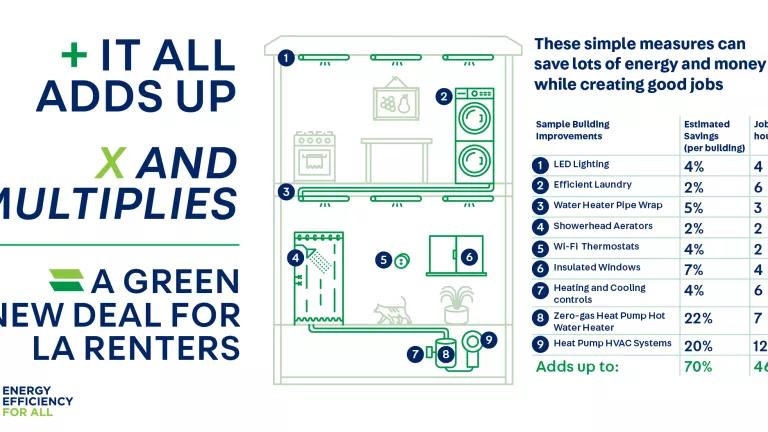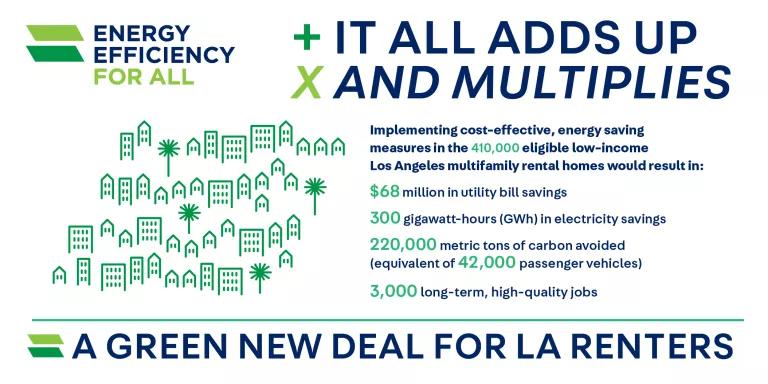Report: “A Green New Deal for Renters” Is Possible

A new report makes a strong case for Los Angeles leaders to reassess the city’s investments in energy efficiency programs to ensure they better serve affordable housing residents who remain deeply underserved by these services. Such investments, which are largely controlled by the city’s utility—Los Angeles Department of Water and Power (LADWP)—could save low-income households $68 million annually, significantly reduce climate emissions, and create 3000 full-time, well-paying jobs in clean energy.
The California Energy Efficiency for All Coalition commissioned the report, Affordable Homes First: A Green New Deal for Renters, presenting Los Angeles with an opportunity to look at how it can invest in comprehensive efficiency programs for lower-income housing as a way to address some of the city’s socio-economic and environmental issues—especially given that multifamily residents in two- or more-unit complexes comprise more than half of LADWP’s customers.
Last month, Mayor Garcetti affirmed the city’s commitment to addressing the climate crisis with the launch of ambitious targets and a plan for a Green New Deal in LA. Last summer, the Los Angeles Department of Water and Power (LADWP) passed a resolution to allocate $100 million in efficiency funds to low-income multifamily housing. Our new report provides concrete strategies for emission reductions, career development opportunities, and living wages for the local workforce—essentially presenting a major building block of what a comprehensive, labor- and community-centered Green New Deal could look like for the city.
The Opportunity
This report finds that expanding programs to better serve renters, whom comprise more than half of LADWP’s customer base—is economically and environmentally sound. Even by the most conservative estimates, analyses commissioned by NRDC show that the following significant benefits are attainable through 2030—and will provide a 200% return on investment:
- Financial Savings: $68 million in annual utility bill savings for participating residents, or approximately $207 per participating household each year;
- Reduced Energy Consumption: Up to 300 gigawatt-hours (GWh) in electricity savings and 22 million therms in gas savings, enough to fully power 50,000 households;
- Emissions Reductions: 220,000 metric tons of carbon avoided—comparable to the annual pollution from 42,000 passenger vehicles; and
- Job Creation: 3,000 long-term, high-quality jobs installing energy-efficiency improvements

Today’s Challenges
While LADWP has accomplished much in its energy efficiency programming, customer interviews and an assessment of model low-income multifamily housing programs point to significant room for improvement. Current challenges include:
- Underserved Customer Segment: None of LADWP’s efficiency programs were designed specifically for multifamily buildings, using industry best practices. This has resulted in long-standing inequities and underinvestment in multifamily customers (property owners and their low-income tenants) compared with single-family homeowners and commercial and industrial customers.
- Unnecessary Complexity: LADWP’s residential energy-efficiency programs have varied eligibility criteria, enrollment procedures, and points of contact. The types of efficiency improvements offered are often unsuitable for multifamily buildings, which makes it difficult for owners to understand their options and see the benefits that would otherwise drive participation.
- Insufficient Commitment and Funding: LADWP has no energy-efficiency target or dedicated budget for this sector and lacks the infrastructure to scale up multifamily programs that provide meaningful savings to tenants and owners. This stands in stark contrast to the fact that multifamily customers in two- or more-unit complexes comprise 55 percent of LADWP’s customers.
- Untimely Funding and Inflexibility: Property owners have limited access to adequate and properly timed incentives; this can make programs offering piecemeal cost reimbursements, rebates, or limited, prescriptive direct-install measures difficult or infeasible for many.
Recommendations
Achieving the potential GHG reductions and equity benefits outlined in this report necessitates action on two levels: first, the development of new resources and programs; and second, a commitment to keep supporting the sector with deep investments and appropriate policy.
The report identifies the following areas of need with new resources and programs:
- Expand Home Energy Improvement Program: LADWP should expand the city’s direct-install Home Energy Improvement Program by creating a tailored offering for multifamily properties. To reach the scale needed, this program would need to expand the Utility Pre-Craft Trainees (UPCT) program and give priority to UPCT and unionized workers to conduct as much work as possible.
- Develop a Targeted Energy & Water Efficiency Program: LADWP should develop a comprehensive, customized, and combined energy- and water-efficiency program that targets, but is not limited to, households in properties with permanently restricted rents. By developing a partnership with the California Department of Community Services and Development (CSD), LADWP could build on existing infrastructure established for the Low Income Weatherization Program.
- Establish a Resource Center: The City of Los Angeles, in coordination with LADWP, should develop a single, outward-facing resource center or one-stop shop for its multifamily program offerings and support it with robust technical assistance and tailored outreach.
To ensure these programs realize their maximum potential, this report recommends that LADWP and the City of Los Angeles provide robust funding, policies, and program design and implementation. These efforts should include the following:
FUNDING: Meaningfully deploy LADWP’s allocated $100 million in affordable-housing, energy-efficiency funding through 2023, followed by a stage two commitment for an additional $725 million in a seven-year program run from 2024 to 2030.
GOALS AND METRICS: Set ambitious program performance goals with transparent indicators of success. Specifically, the city in tandem with LADWP should commit to:
- Reducing energy use in all lower-income multifamily buildings by at least 20 percent by 2030—which would provide a 200% return on investment for the utility
- Serving a minimum of 25,000 low-income households annually in order to benefit at least 275,000 low-income, rental households by 2030
PARTICIPATION AND CUSTOMER VALUE: LADWP should scale up program access and participation by:
- Providing robust technical assistance to affordable housing owners
- Augmenting LADWP’s existing Community Partnership grants program for nonprofits and providing quality, multilingual community-based outreach
- Targeting outreach so that priority is given to investments in areas with the greatest energy burdens (the percentage of income spent on utility bills) and need, such as the San Fernando Valley and South Los Angeles
- Redesigning efficiency-program incentives and requirements to consider and minimize renters’ risk of displacement during and following upgrades
- Encouraging programs to hire locally and pay contractors living wages
The Path Ahead
This report provides one clear roadmap of actions developed by labor and community-based organizations representing front-line communities that show the city what action it needs to take to realize its ambitious aims. By starting with the most underserved building infrastructure, Los Angeles can maximize economic benefits while ensuring that equity remains at the center of its plan.
The seriousness of today’s climate and affordability crises behooves leaders to take bold action. This report provides a clear course of action that is implementable now and will bring tangible benefits to our environment, economy, and equity goals.
Energy Efficiency for All in Los Angeles, which includes LAANE, NRDC, and California Housing Partnership, among others, in partnership with the RePower LA Coalition, stands ready to support LADWP and the city in acting on these recommendations.
The question on the table is whether our leaders will muster the political will to move it forward.



